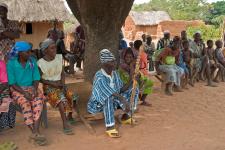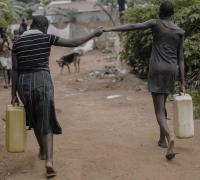Loss and damage and social cohesion

Social cohesion is increasingly emerging as a critical aspect of climate-related losses and damages. At the same time, developments at COP28 pave the way for ramped-up loss and damage responses on the ground. But how much do we know about social cohesion challenges in relation to climate change and displacement and how can this inform next steps for programming and practice?
’Social cohesion’ refers to a dynamic quality of social relations that is linked to a shared sense of identity, values and norms.
In policy and programming, social cohesion is defined differently by different actors, prompting different approaches and programming aims.
Social cohesion – the social fabric within a community, linked to shared values, identity and sense of belonging – has been increasingly recognized as important in relation to development, conflict, and human mobility. Clear links are also emerging between social cohesion and climate change: research is increasingly documenting how climate impacts and climate-related mobility are impacting social cohesion.
Increasing recognition of the pressures on social cohesion from conflict, climate change and forced mobility – as well as its importance for well-being and developmental outcomes – point to the need for further engagement.
This brief supports further work with social cohesion by presenting key points from a review of academic and gray literature on social cohesion, focusing on links to climate change and displacement. It is part of the study ‘Displacement, climate change and social cohesion: Exploring loss and damage dynamics’, a collaborative initiative between the Danish Institute for International Studies, the Danish Red Cross, researchers at SD Dombo University in Ghana, and Niger Red Cross staff and volunteers.
The following three sections present key points on social cohesion in relation to: (1) climate impacts and loss and damage, (2) climate displacement and responses, and (3) next steps for policy and programming.
Climate impacts and social cohesion
Increasingly, climate change impacts as well as climate-related initiatives have been linked to social cohesion. Both positive and negative impacts have been observed, but overall, there are more documented instances of negative social cohesion impacts from climate impacts.
Documented negative climate-related impacts include those to social relations and support networks. Climate-related stress has, for instance, undermined systems of mutual support that strengthen social bonds within a community, provide improved livelihood outcomes, or provide coping mechanisms, e.g. through food, labor or credit-sharing schemes.
Yet some positive social cohesion outcomes have also been observed – extreme weather events have, for example, prompted community mobilization and mutual support. This echoes other examples of increased forms of social cohesion in times of crisis, both in the aftermath of extreme events and conflict-related displacement.
Within the international response, social cohesion is linked to climate change and response through ‘loss and damage’, as a form of non-economic losses and damages. This was previously fairly limited, for instance under fields of cultural heritage and indigenous local knowledge. But emerging findings indicate it is a broader issue, also linked to aspects of loss and damages including mobility, health and sense of place.
Recognition of negative impacts to social cohesion as non-economic losses places more emphasis on the intrinsic value of social cohesion, rather than its instrumental value in improving livelihoods and resilience. Both are important for communities and response efforts.
Losses and damages are also recognized as highly context- and value-based, which is very much the case for social cohesion. A context-, value-based approach will likely support more relevant and successful efforts to assess and address losses of social cohesion.
- Loss and damage: Negative climate-related impacts to social cohesion are forms of non-economic losses and damages. They are increasingly linked to a broad range of other non-economic losses, e.g. mobility and culture.
- Mixed cohesion outcomes: Purely negative social cohesion outcomes due to climate impacts cannot be assumed. Aspects of strengthened social cohesion and mobilization have been observed in times of crisis.
- Context & values: Social cohesion, and the factors affecting it, are highly context-based, adding complexity to policy and programming efforts. However, contextual, value-based approaches to addressing loss and damage are well-suited to capturing this.
- Intrinsic value: A loss and damage approach to social cohesion highlights its intrinsic value, supporting greater attention to and programming on non-instrumental aspects of cohesion.
Linking to displacement and responses
Existing policy and programming on social cohesion focuses largely on displaced and refugee communities in destination areas. This has included attention to social cohesion dynamics within displaced populations, between displaced and host communities, and between communities and institutions/ governance structures.
Particular focus has been on social cohesion challenges in the relationship between displaced persons or groups and host communities. Displacement can disrupt social ties within receiving areas, especially when host communities perceive threats to their identity or resources, and this has been linked to conflicts and worsened development outcomes across groups.
Emerging findings also point to negative social cohesion impacts in displaced and migrant sending areas. However, these have previously received little attention, suggesting the need for more focus on the family members and communities who stay behind.
Existing efforts relevant to strengthening social cohesion in contexts of displacement involve social engagement, institutional and governance dimensions, service provision, social protection measures, and psychosocial support.
- Receiving areas: To date, focus has primarily been on social cohesion in receiving areas, particularly in relations between displaced and host communities.
- Sending areas: Sending areas have been largely overlooked in research and programming, but require greater attention; findings indicate negative social cohesion impacts among those who stay behind.
- Existing programming: Relevant existing programming exists in relation to extreme events and displacement, e.g. psychosocial support, social protection, service provision, socio-cultural activities, and institutional development.
Next steps for programming and practice
Greater attention to social cohesion among international organizations is translating into increased policy and programming on the topic, especially regarding displacement. However, different actors and organizations define social cohesion differently, leading to different policy and programming approaches and aims.
Efforts to inform further social cohesion policies and programming can draw on new assessments and learning from existing efforts. Assessing social cohesion requires context-based indicators, including perceptions and subjective experiences of those affected – including mobile, host and home populations – and should disaggregate to shed light on differentiated experiences for different social groups.
Learning from existing efforts shows that interventions can exacerbate tensions between displaced and host communities, especially when there is a perception of unfairness. Inclusive policies addressing needs of both displaced and host communities can foster better social cohesion. Encouraging cultural exchange, providing accurate information, and creating shared spaces have also been shown to reduce tensions.
Particular attention should be given to marginal and disadvantaged groups. Reproducing existing forms of social cohesion and social relations may reinforce pre-existing inequalities.
Governance, representation, and inclusion are also significant for successful programming and practice. Effective local leadership, bottom-up representation, and inclusion of those affected are crucial for greater social cohesion, with particular attention to marginalized groups.
- Assessing cohesion: Assessing social cohesion in situations of climate-related mobility and displacement can be challenging and requires context-based indicators, including of perceptions and subjective experiences. Assessments should disaggregate demographic and social groups to shed light on differentiated experiences and challenges.
- Programming risks: Interventions themselves can negatively affect social cohesion, especially when there are perceptions of unfairness between groups, and should avoid reproducing existing forms of marginalization and inequality.
- Representation & inclusion: Effective local leadership, bottom-up representation, and inclusion of those affected are crucial for greater social cohesion, with particular attention to marginalized groups.

DIIS Experts


